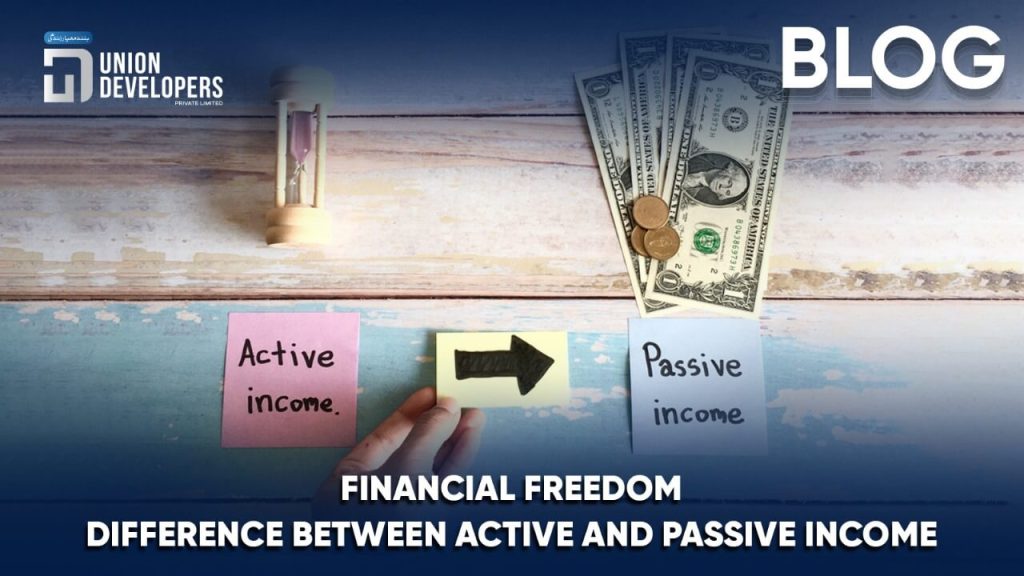The constant flow of multiple incomes is an aim that every individual aspires to achieve. However, to attain this goal one has to adopt more than one mode of earning. People come across two of the most critical features when they are trying to learn about different sources of income. All of us are familiar with the terms, active income and passive income. But what is the difference between active and passive income? The opportunities and risks in each? And how can one use the concept of active/passive income to achieve the envisioned financial outcome?
What is Active Income?
Active income is associated with earnings that one generates directly through work or services that one offers. Or simply we can define active income as received by a job or a business venture that constantly requires your attention and one has to be actively involved in it without a break.

Salaries and Wages: A system from which people are paid regularly for completing their work tasks like for example developing software, nursing patients, teaching or working in some industry as an engineer.
Self-Employment: Generating income from running a personal business consultancy, freelance work or owning a business venture.
Commissions and Bonuses: Overtime payments that are earned during a regular job while working for extra hours or sales in specific projects.
Gross Income is usually charged a higher rate of taxation in comparison to passive income as it describes a more regular income. Nevertheless; it also results in a lack of free time and insufficient time to relax and engage in other activities. Resulting in success and growth depending upon continuous work and constant efforts.
What is Passive Income?

Conversely, passive income is earned without direct effort or time input into routine work. It can come from various sources, including:
Investments: Annual, quarterly or monthly income coming from the stock exchange market and properties such as shares or interest on bonds or rental income among others, where an individual’s initial effort is used but it does not require regular effort.
Rental Income: Investment or other forms of earnings that involve business like renting out properties without the owner directly meddling in the operations of the property.
Interest Income: Getting a nice amount of interest from investments, treasury bills, bonds or any other form of fixed deposits.
The major benefits that can be associated with passive income include; enjoying more favorable tax treatment than active income and it does not consuming time and it is flexible. However, hidden within the tax dividend strategy, passive income investments can be relatively more vulnerable to market and other shocks.
Active vs Passive Income
Taxation: It is widely recognized that active income is taxed more than passive income which is given more preferential treatment.
Risk and Ambiguity: Some are more exposed to risks in the market and other related factors than active income, which is more reliable in terms of steady income generation.
Time Commitment: Active income demands more time and energy, while passive income is more time-sensitive and flexible.
Lifestyle Impact: While active income can prevent one from gaining decent spare time and work-life balance, passive income offers more flexibility.
Main Difference Between Active and Passive Income
Relative to active and passive income having their strengths and weaknesses, the best course of action is to have both. This could affiliate with diversification, flexibility or tax advantages.
Invest in Dividend-Paying Stocks: Spend a part of your active income to buy stocks that have the potential to give out dividends which can be a good source of passive income.
Start a Side Hustle: Your skills and expertise should help you to start a side business or freelance work, as this will add to your active income.
Rent Out a Room or Property: If you have any vacant space in the house or own a house or an apartment or any other property, you can rent it out and increase your passive income.
Create and Sell Digital Products: Use your expertise in developing a market for tangible goods that are accessible over the internet and in this way, you generate extra cash.
Trends in Active and Passive Revenue Generation
To have an excellent plan, an individual should be well-equipped to generate both active and passive income.
Develop Marketable Skills: Furnish your education and training in areas that will demand more skills and pay better, in short, higher rates.
Start Your Business: If you are an aspiring entrepreneur, then it is high time you ought to venture into a business since this would present you with chances of active and passive income.
Invest in Real Estate: Real Estate can also be a pathway to earn passive income through rents or investment in a Real Estate Investment Trust (REIT).
Diversify Your Investments: Diversify by investing across the spectrum, in the stock market, bonds and properties as this will minimize risk while earning passive income from different opportunities.
Conclusion
One of the important fundamentals that a person needs to grasp is the difference between active and passive income. Therefore, tapping on both these sources of inflows creates a stronger and more diversified source of funding for the business. As mentioned, developing more sources of income does not happen overnight but in the long run, such an endeavour can lead to enhanced income, together with valuable options and freedom.
First, begin with an evaluation of your strengths, assets and objectives: ensure that you design a specific strategy of achieving income with active income and other passive income. If you stay committed to the process no matter how challenging it may get, eventually it will lead you to success.








